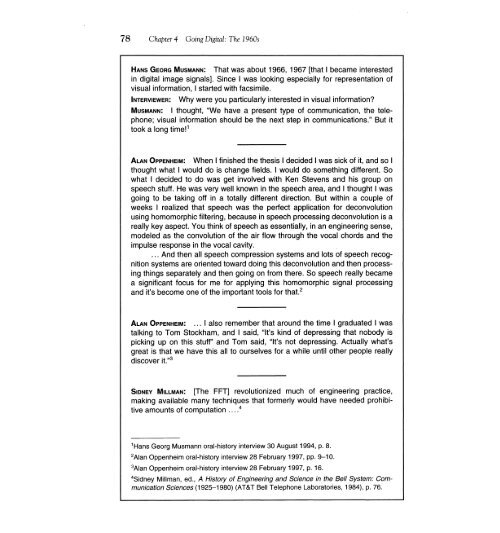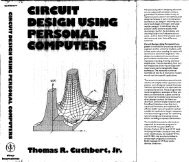Going Digital: The 1960s - IEEE Global History Network
Going Digital: The 1960s - IEEE Global History Network
Going Digital: The 1960s - IEEE Global History Network
You also want an ePaper? Increase the reach of your titles
YUMPU automatically turns print PDFs into web optimized ePapers that Google loves.
78 Chapter 4 <strong>Going</strong> <strong>Digital</strong>: <strong>The</strong> 19605<br />
HANS GEORG MUSMANN: That was about 1966, 1967 [that I became interested<br />
in digital image signals]. Since I was looking especially for representation of<br />
visual information, I started with facsimile.<br />
INTERVIEWER:<br />
Why were you particularly interested in visual information?<br />
MUSMANN: I thought, "We have a present type of communication, the telephone;<br />
visual information should be the next step in communications." But it<br />
took a long time!1<br />
ALAN OPPENHEIM: When I finished the thesis I decided I was sick of it, and so I<br />
thought what I would do is change fields. I would do something different. So<br />
what I decided to do was get involved with Ken Stevens and his group on<br />
speech stuff. He was very well known in the speech area, and I thought I was<br />
going to be taking off in a totally different direction. But within a couple of<br />
weeks I realized that speech was the perfect application for deconvolution<br />
using homomorphic filtering, because in speech processing deconvolution is a<br />
really key aspect. You think of speech as essentially, in an engineering sense,<br />
modeled as the convolution of the air flow through the vocal chords and the<br />
impulse response in the vocal cavity.<br />
... And then all speech compression systems and lots of speech recognition<br />
systems are oriented toward doing this deconvolution and then processing<br />
things separately and then going on from there. So speech really became<br />
a significant focus for me for applying this homomorphic signal processing<br />
and it's become one of the important tools for that. 2<br />
ALAN OPPENHEIM: ... I also remember that around the time I graduated I was<br />
talking to Tom Stockham, and I said, "It's kind of depressing that nobody is<br />
picking up on this stuff" and Tom said, "It's not depressing. Actually what's<br />
great is that we have this all to ourselves for a while until other people really<br />
discover it.,,3<br />
SIDNEY MILLMAN: [<strong>The</strong> FFT] revolutionized much of engineering practice,<br />
making available many techniques that formerly would have needed prohibitive<br />
amounts of computation .... 4<br />
1Hans Georg Musmann oral-history interview 30 August 1994, p. 8.<br />
2Alan Oppenheim oral-history interview 28 February 1997, pp. 9-10.<br />
3Alan Oppenheim oral-history interview 28 February 1997, p. 16.<br />
4Sidney Millman, ed., A <strong>History</strong> of Engineering and Science in the Bell System: Communication<br />
Sciences (1925-1980) (AT&T Bell Telephone Laboratories, 1984), p. 76.
















